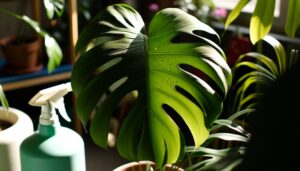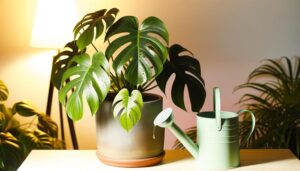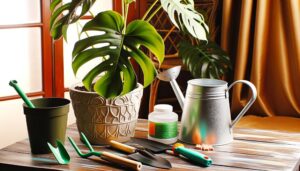Monstera Borsigiana Care Guide
To look after your Monstera Borsigiana, provide bright, indirect light for 6-8 hours daily, avoiding direct sunlight. Water when the top 2-3 inches of soil are dry, and use a well-draining mix of potting soil, orchid bark, perlite, and compost.
Opt for pots 2-4 inches larger than the root ball with proper drainage holes. Fertilize every 4-6 weeks with a balanced, water-soluble fertilizer during the growing season.
Prune yellow or damaged leaves close to the main stem and trim leggy stems above a node. To make sure your plant thrives, you can also explore specific techniques and common issues.

Key Takeaways
- Place Monstera Borsigiana in bright, indirect light and avoid direct sunlight to prevent leaf scorching.
- Water when the top 2-3 inches of soil are dry and ensure proper drainage to prevent root rot.
- Use a well-draining soil mix with potting soil, orchid bark, perlite, and compost for optimal growth.
- Fertilize with a balanced, water-soluble fertilizer every 4-6 weeks during the growing season, using half-strength.
- Prune yellow or damaged leaves with sterilized shears and trim leggy stems above a node for bushier growth.
Light Requirements
To achieve optimal growth, place your Monstera Borsigiana in bright, indirect light. This lighting condition mimics the plant's natural habitat under a forest canopy, guaranteeing it receives ample light without direct sun exposure.
Direct sunlight can scorch the leaves, causing unsightly brown spots and hindering growth. Aim for a location where the plant receives filtered light for about 6-8 hours daily. East or north-facing windows are ideal. If natural light is insufficient, consider using artificial grow lights to supplement.
Maintain a consistent light source to avoid stress. Rotate the plant periodically to ensure uniform light distribution and symmetrical growth. By optimizing light conditions, you'll promote lush, healthy foliage and robust development in your Monstera Borsigiana.
Watering Schedule
Establishing a consistent watering schedule is essential for the health and growth of your Monstera Borsigiana. Water your plant when the top 2-3 inches of soil feel dry. Use a moisture meter for accuracy. Overwatering can lead to root rot, while underwatering causes leaf curling. Aim for a balance, adjusting based on environmental conditions.
| Condition | Watering Frequency |
|---|---|
| Warm and Humid | Every 5-7 days |
| Cool and Dry | Every 10-14 days |
| Air-conditioned Room | Every 7-10 days |
Ensure proper drainage to prevent water accumulation. Use room-temperature water and avoid letting the plant sit in water. Consistency is key, so develop a routine and monitor your Monstera's response to fine-tune your approach.
Soil and Potting
To maximize the health of your Monstera Borsigiana, concentrate on ideal soil composition, correct pot size, and sufficient drainage.
Use a well-aerated mix containing peat, perlite, and orchid bark to support root health.
Select a pot that provides space for growth while making sure it has drainage holes to avoid waterlogging.
Optimal Soil Composition
For peak Monstera Borsigiana growth, ensure the soil is a well-draining mix rich in organic matter, which aids in aeration and moisture retention. Use a combination of 40% potting soil, 20% orchid bark, 20% perlite, and 20% compost.
Potting soil provides essential nutrients, while orchid bark enhances aeration. Perlite improves drainage and prevents soil compaction, ensuring roots receive sufficient oxygen. Compost enriches the soil with organic matter, promoting healthy root development.
Avoid heavy, clay-based soils as they retain excessive moisture and can cause root rot. Regularly check soil moisture levels and adjust watering schedules accordingly. This precise blend will create an ideal environment for your Monstera Borsigiana, supporting robust growth and vibrant foliage.
Proper Pot Size
Choosing the correct pot size is important for providing your Monstera Borsigiana with ample space for root expansion and optimal growth. Select a pot that's 2-4 inches larger in diameter than the root ball. This encourages healthy root development without overwhelming the plant.
To help you choose the right pot, consider the following:
- Material: Use terracotta pots for improved air circulation.
- Weight: Heavier pots offer stability for larger plants.
- Shape: Deep pots help support extensive root systems.
- Size: Gradually increase pot size to prevent root rot and overwatering.
These factors ensure your Monstera Borsigiana has the ideal environment for strong growth. Always keep an eye on the plant's root system to determine when it's time for repotting.
Drainage Requirements
Proper drainage is necessary for Monstera Borsigiana, guaranteeing that excess water escapes quickly to prevent root rot and promote healthy growth. Choose a well-draining potting mix, ideally one that combines peat moss, perlite, and orchid bark. This mix provides a balance of moisture retention and aeration.
Your pot should have drainage holes; without them, water stagnates and suffocates the roots. A pot with a saucer that can be emptied regularly is ideal. When repotting, make sure the new pot is only slightly larger to avoid waterlogging.
Water the plant thoroughly but allow the soil to dry out between waterings. Monitoring the soil moisture level helps prevent overwatering, which is essential for maintaining your Monstera Borsigiana's health.
Fertilization Tips
Feeding your Monstera Borsigiana with a balanced, water-soluble fertilizer every 4-6 weeks during the growing season guarantees peak health and growth. Maintain that the fertilizer has equal parts nitrogen, phosphorus, and potassium. Use half the recommended strength to prevent nutrient burn. Remember to water the plant before applying the fertilizer to avoid root damage.
Key fertilization tips include:
- Choose a balanced, 20-20-20 fertilizer: This secures equal nutrient distribution.
- Thin out the fertilizer to half-strength: Safeguards the plant from over-fertilization.
- Provide nutrients during the growing season: Usually spring and summer.
- Refrain from fertilizing in winter: The plant's growth slows down, reducing nutrient needs.
Adhering to these guidelines will help your Monstera Borsigiana thrive.
Pruning Techniques
While proper fertilization guarantees robust development, understanding effective pruning techniques is equally crucial for maintaining the shape and health of your Monstera Borsigiana.
Begin by sterilizing your pruning shears to prevent infections. Focus on removing yellow or damaged leaves first, cutting close to the main stem. Trim aerial roots sparingly; they aid in nutrient absorption.
To promote bushier growth, prune back leggy stems just above a node. Always make clean cuts at a 45-degree angle to minimize harm. Pruning in spring or early summer is optimal, as it aligns with the plant's natural growth cycle.
Regularly assess your Monstera for overcrowded areas and thin them to allow better air circulation. Implementing these techniques guarantees a healthier, more vibrant plant.
Common Issues
Caring for Monstera Borsigiana often involves addressing common issues like leaf yellowing, root rot, and pest infestations. To guarantee your plant thrives, you need to identify and manage these problems effectively.
- Leaf Yellowing: Often caused by overwatering or insufficient light. Adjust watering frequency and relocate your plant to a brighter spot.
- Root Rot: Results from waterlogged soil. Ensure proper drainage and consider repotting with a well-draining mix.
- Pest Infestations: Common pests include spider mites and mealybugs. Use neem oil or insecticidal soap for treatment.
- Brown Leaf Tips: Frequently due to low humidity or over-fertilization. Increase humidity levels and reduce fertilizer application.
Conclusion
Caring for your Monstera borsigiana might feel like a journey, but remember, even the greatest explorers like Indiana Jones had maps.
With the right light, watering schedule, soil, fertilization, and pruning, your plant will thrive.
Be vigilant for common issues, and you'll navigate them with ease.
Stick to these guidelines, and your Monstera will become a lush, vibrant centerpiece in your home, showcasing the beauty of nature's wonders.
Happy growing!






